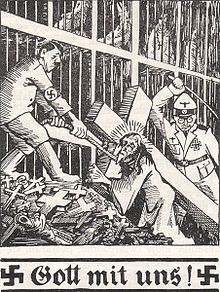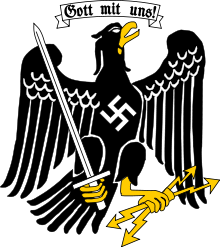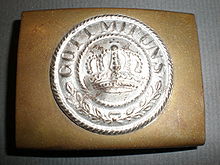- Gott mit uns
-
 A satirical propaganda poster by the Polish Action "N" during WWII entitled Gott mit uns, after the Wehrmacht belt buckle inscription; Adolf Hitler on the left, Heinrich Himmler on the right
A satirical propaganda poster by the Polish Action "N" during WWII entitled Gott mit uns, after the Wehrmacht belt buckle inscription; Adolf Hitler on the left, Heinrich Himmler on the right
 The Prussian coat of arms, 1933
The Prussian coat of arms, 1933
Gott mit uns (meaning God with us) is a phrase commonly associated with the German military from the German Empire to the end of the Third Reich, although its historical origins are far older, ultimately tracing back to the Hebrew term Immanuel from the Bible. The Russian Empire's motto also translates to this.
Contents
Origins
Nobiscum deus ('God with us') was a battle cry of the late Roman Empire and of the Byzantine Empire.[1] In the 17th century, the phrase Gott mit uns was used as a 'field word', a means of recognition akin to a password,[2] by the army of Gustavus Adolphus at the battles of Breitenfeld (1631), Lützen (1632) and Wittstock (1636) in the Thirty Years' War.[3] In 1701, Frederick I of Prussia changed his coat of arms as Prince-Elector of Brandenburg. The electoral scepter had its own shield under the electoral cap. Below, the motto Gott mit uns appeared on the pedestal.
Usage
 Frederick I of Prussia's coat of arms from a woodcut, 1709
Frederick I of Prussia's coat of arms from a woodcut, 1709
The Prussian Order of the Crown was Prussia's lowest ranking order of chivalry, and was instituted in 1861. The obverse gilt central disc bore the crown of Prussia, surrounded by a blue enamel ring bearing the motto of the German Empire Gott Mit Uns.
At the time of the completion of German unification in 1871, the imperial standard bore the motto Gott mit uns on the arms of an Iron Cross.[4] Imperial German 3 and 5 mark silver and 20 mark gold coins had Gott mit uns inscribed on their edge.
German soldiers had Gott mit uns inscribed on their helmets in the First World War.[5] To the Germans it was a rallying cry, "a Protestant as well as an Imperial motto, the expression of German religious, political and ethnic single-mindedness, or the numerous unity of altar, throne and Volk".[6] The slogan entered the mindset on both sides; in 1916 a cartoon was printed in the New York Tribune captioned "Gott Mit Uns!", showing "a German officer in spiked helmet holding a smoking revolver as he stood over the bleeding form of a nurse. It symbolized the rising popular demand that the United States shed its neutrality".[7]
In June 1920 George Grosz produced a lithographic collection in three editions entitled Gott mit uns. A satire on German society and the counterrevolution, the collection was swiftly banned. Grosz was charged with insulting the army, which resulted in a 300 German Mark fine and the destruction of the collection.[8]
During the Second World War Wehrmacht soldiers wore this slogan on their belt buckles,[9] as opposed to members of the Waffen SS, who wore the motto Meine Ehre heißt Treue ('My honour is loyalty').[10]
References
- ^ Haldon, John; ''Warfare, State and Society in the Byzantine World'', p. 24; Taylor & Francis, Inc., 1999; ISBN 9781857284959. Books.google.com. http://books.google.com/books?id=-R0G0Enf58AC&pg=PA24&dq=%22nobiscum+deus%22+roman+empire&lr=. Retrieved 2009-07-24.
- ^ Young, Alan R. (ed); ''The English Emblem Tradition: Volume 3: Emblematic Flag Devices of the English Civil Wars, 1642-1660 Index Emblematicus'' p. xxiv; University of Toronto Press, 1995. Books.google.be. http://books.google.be/books?id=uGBG25-u67kC&pg=PR24&lpg=PR24&dq=%22field+signs+and+field+words&source=bl&ots=HbhxafIWft&sig=PG1F92g3_UhduwFuBpSbsNZFO9o&hl=en&sa=X&oi=book_result&resnum=2&ct=result. Retrieved 2009-07-24.
- ^ Brzezinski, Richard; ''The Army of Gustavus Adolphus (2): Cavalry (Men-at-Arms)'', p. 21; Osprey Publishing, 1993; ISBN 1855323508. Books.google.com. http://books.google.com/books?id=YylYMtCMz2UC&pg=PA21&dq=%22Gott+mit+uns&lr=. Retrieved 2009-07-24.
- ^ Preble, George Henry, History of the Flag of the United States of America: With a Chronicle of the Symbols, Standards, Banners, and Flags of Ancient and Modern Nations, 2nd ed, p. 102; A. Williams and co, 1880
- ^ Spector, Robert Melvyn; ''World Without Civilization: Mass Murder and the Holocaust, History, and Analysis'', p. 14; University Press of America 2004; ISBN 9780761829638. Books.google.com. http://books.google.com/books?id=xZ5Ceq6l0M0C&pg=PA14&dq=Kaiser+Wilhelm+%22Gott+mit+uns%22&lr=. Retrieved 2009-07-24.
- ^ Davies, Alan T.; ''Infected Christianity: A Study of Modern Racism'', p. 42; McGill-Queens University Press, 1988; ISBN 9780773506510. Books.google.com. http://books.google.com/books?id=n4Eo9JpM3LsC&pg=PA42&dq=%22Gott+mit+uns&lr=. Retrieved 2009-07-24.
- ^ Hoehling, Adolph A.; The Great War at Sea: A History of Naval Action, 1914-18, p. 106; Crowell, 1965; ISBN 1566197260
- ^ Crockett, Dennis; ''German Post-Expressionism: The Art of the Great Disorder, 1918-1924'', pp. 28-29; Penn State University Press, 1999; ISBN 9780271017969. Books.google.com. http://books.google.com/books?id=EQzdp1zN--oC&pg=PA28&dq=%22Gott+mit+uns&lr=#PPA29,M1. Retrieved 2009-07-24.
- ^ Armbrüster, Thomas; ''Management and Organization in Germany'', p. 64; Ashgate Publishing, 2005 ISBN 9780754638803. Books.google.com. http://books.google.com/books?id=fd1V26tIjuEC&pg=PA64&dq=first+world+war+%22Gott+mit+uns%22&lr=. Retrieved 2009-07-24.
- ^ McConnell, Winder; ''A Companion to the Nibelungenlied'', p. 1; Boydell & Brewer, 1998; ISBN 9781571131515. Books.google.com. http://books.google.com/books?id=wu0B6_XO3boC&pg=PA1&dq=%22Gott+mit+uns%22+SS&lr=. Retrieved 2009-07-24.
External links
- Gott Mit Uns Time Magazine archive article
Categories:- House of Hohenzollern
- German words and phrases
Wikimedia Foundation. 2010.

